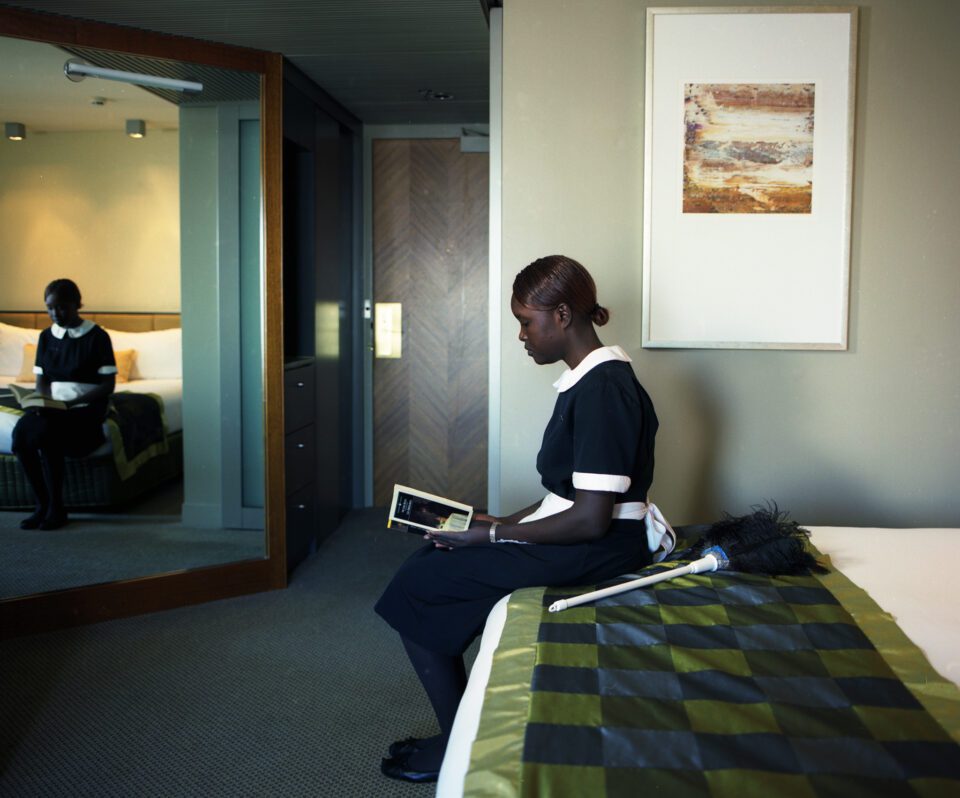Anne Zahalka (b. 1957) stands as one of Australia’s most celebrated photo-media artists, boasting a career spanning more than four decades. Her photography explores cultural and environmental points of tension, as she deconstructs familiar settings, reassembling them to offer up poised, alternative narratives. Central to the artist’s approach is the use of humour, intrigue and a discerning eye, as she prompts viewers to contemplate on themes such as cultural diversity within Australian society and the ecological impact of the ongoing climate crisis. ZAHALKAWORLD — an artist’s archive, running until 10 September at Museum of Australian Photography (MAPh), is a major survey that brings together key bodies of work that span Zahalka’s practice presented, alongside collected treasures from her archive that inform and inspire her.

The exhibition invites audiences into the Zahalka’s working life and her creative process to explore the illusionary worlds for which she is renowned. In the series Wild Life (2006-17), the artist plays with concepts of dioramas and habitat display. This resonates in Exotic Birds (2017) where traces of reality such as discarded boxes, cans and wrappers litter a staged forest floor, further replete with stuffed avian creatures. In the centre of the image, a figure dressed in pink reaches out to take a photograph of a looming volcano. Zahalka plays with the concept of archive and artifice, experimenting with the real and imagined as she stages a mannequin in front of a painted wall. The work calls to attention concepts of cultural degradation and extinction, reminiscent of mixed-media artists such as Wendy Red Star and Martine Gutierrez, who through parodied displays, work towards making Indigenous experiences actualised and powerful. “In this exhibition, Zahalka digitally disrupts, hand-colours, and evolves archival photographs of historic Australian habitat displays so they become bearers of contemporary meanings and inferences,” Arc One Gallery, who exhibited Wild Life in 2019 explains, “Based on the damaging carbon footprint left by tourism, industry, and population growth, the digital interventions within Zahalka’s re-imagined displays point to the ongoing negative impact humans have had on the natural world and the need to take action.”

Elsewhere, series such as Hotel Suite (2008) are drawn into focus. Here, the artist focuses on the intimacy of a hotel room, adding dimension to seemingly benign and ordinary moments. Viewers become voyeurs, as guests and hospitality staff become the object of an audience’s gaze, trapped in the temporal space of a hotel. Notions of alienation, longing and desire combine in moments of quiet solitude. A man in a suit holds his head in his hands, sitting in an orange armchair in his socks. A suited woman gazes onto a high-rise view in a public bathroom. In Room 3621, a maid sits on a pristinely made up bed, reading a book. On the left side of the image, the scene is reflected, offering a second vantage point to the photograph. A sense of entrap-ment dominates the picture, furthered by the use of leading lines through objects such as a checkerboard duvet cover, a rectangular mirror, a picture frame and a block of parallel walls. Zahalka draws out a display according to rigid and tabulated boundaries, where placement is immaculate, all the while increasing feelings of estrangement and surveillance.
Elsewhere, the artist’s preeminent work Bondi: a playground of the Pacific (1989) is on display. Saturated photographs of figures clad in swimming costumes and supine on beaches paint a colourful and exuberant landscape. As artist and writer Martyn Jolly notes, “Each tableau illustrates one aspect of Bondi’s cultural cavalcade. These portraits share their premise with the 19th century studio portrait — in which backdrops, clothing, furniture and pose were deployed in order to install the sitter in a pre-existent social niche.”

The combination of the public and the private, the intellectual and informal, culminates in a recreation of the artist’s house-studio within MAPh’s gallery space. “This immersive area provides a deeper under-standing of the conceptual and practical aspects of an artist’s methods which are often hidden and unseen by the public,” notes Anouska Phizacklea, MAPh Director. The resulting exhibition is a comprehensive record of the ever-evolving multicultural identity of Australia. It observes and engages with topics of past and present, as it blends the fields of social documentary, portraiture, photo-montage and digital editing together. In these works, Zahalka carves out a powerful visual language, as she encourages viewers to look more closely at the intricacies of the landscapes, symbols and subtext of the world around us.
ZAHALKAWORLD – an artist’s archive
maph.org.au | Until 10 September
Words: Chloe Elliott
Image Credits:
1. Anne Zahalka, The Sunbather #2 (1989)
2. Anne Zahalka, Exotic Birds (2017)
3. Anne Zahalka, 3621 (2008)
4. Anne Zahalka, The Artist (self portrait) (1988)





